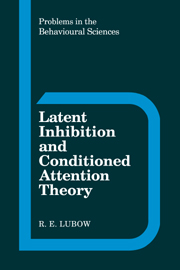Book contents
- Frontmatter
- Contents
- Preface
- 1 Introduction
- 2 Latent inhibition testing procedures
- 3 Variables affecting latent inhibition
- 4 Organismic variables affecting latent inhibition
- 5 Associative learning tests of the effects of stimulus preexposure in children and adults
- 6 Neural substrates of latent inhibition
- 7 Theories and explanations of latent inhibition in animals
- 8 Conditioned attention theory of latent inhibition
- 9 Conditioned attention theory as applied to latent inhibition in humans
- 10 Some applications of conditioned attention theory: learned helplessness and schizophrenia
- Notes
- References
- Author index
- Subject index
6 - Neural substrates of latent inhibition
Published online by Cambridge University Press: 13 October 2009
- Frontmatter
- Contents
- Preface
- 1 Introduction
- 2 Latent inhibition testing procedures
- 3 Variables affecting latent inhibition
- 4 Organismic variables affecting latent inhibition
- 5 Associative learning tests of the effects of stimulus preexposure in children and adults
- 6 Neural substrates of latent inhibition
- 7 Theories and explanations of latent inhibition in animals
- 8 Conditioned attention theory of latent inhibition
- 9 Conditioned attention theory as applied to latent inhibition in humans
- 10 Some applications of conditioned attention theory: learned helplessness and schizophrenia
- Notes
- References
- Author index
- Subject index
Summary
In the past, the extensive efforts to understand latent inhibition were directed at behavioral analyses of the phenomenon, the data from which we have discussed at some length in the previous chapters. More recently, however, a keen interest has developed in the neural substrates of latent inhibition. Although this certainly reflects a general trend in the experimental psychology of learning, the additional focus also can be partially explained by the relatively new interest in the area of attention among psychologists, as well as by the consensual opinion that latent inhibition reflects some aspect of attention (e.g., Lubow, Weiner, & Feldon, 1982). More specific manifestations of this direction can be seen in various attempts to evaluate the attentional deficits of schizophrenia by assessing impairments of latent inhibition (Baruch et al., 1988a,b; Lubow et al., 1987) and, at the same time, to explore the animal amphetamines model of schizophrenia by examining the effects of amphetamines as well as neuroleptics on latent inhibition in animals (e.g., Solomon et al., 1981; Solomon & Staton, 1982; Weiner et al., 1984; Weiner & Feldon, 1987; Weiner, Feldon, & Katz, 1987; Weiner, Lubow, & Feldon, 1981). In addition to these efforts, which will be described in the section on the effects of dopaminergic manipulations on latent inhibition, other brain systems have also been studied in this regard. These will be reviewed and discussed separately in sections on noradrenergic, serotonergic, cholinergic, septo-hippocampal, and opiate manipulations.
- Type
- Chapter
- Information
- Latent Inhibition and Conditioned Attention Theory , pp. 130 - 140Publisher: Cambridge University PressPrint publication year: 1989



